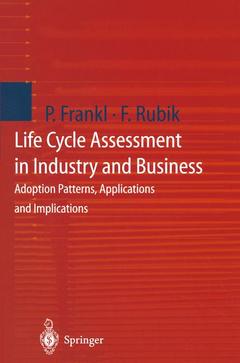Description
Life Cycle Assessment in Industry and Business, Softcover reprint of hardcover 1st ed. 2000
Adoption Patterns, Applications and Implications
Authors: Frankl Paolo, Rubik Frieder
Language: English
Subjects for Life Cycle Assessment in Industry and Business:
Approximative price 147.69 €
In Print (Delivery period: 15 days).
Add to cart
Publication date: 12-2010
280 p. · 15.5x23.5 cm · Paperback
280 p. · 15.5x23.5 cm · Paperback
Description
/li>Contents
/li>Comment
/li>
1.1 Life Cycle Assessment (LeA): a fascinating and sophisticated tool The greening of the economy is not a new task, but it is a challenge for which a lot of tasks still have to be done. It is known that the main source of environ mental deterioration by industry is not any more the chimneys and other process related emissions, but the products and services produced. Products are regarded as carriers of polIution: they are not only a potential source of polIution and waste during their use; they are also a cause of resource depletion, energy consumption, and emissions du ring their life starting with the extraction of the raw materials and ending with their disposal (i.e. connecting production and consumption stages). The challenge of these decades is now the greening of products and services. The new focus on products (cp. OosterhuislRubik/ScholI 1996) was introduced as a policy approach of shared responsibility in which different actors are in volved along the life-cycle of a product, each having specific responsibilities.
1 Introduction.- 2 Framework and theoretical background.- 3 Application of LCA in general.- 4 A “static” perspective on LCA applications — Survey results.- 5 The dynamics of LCA adoption and integration in the firm — The results of the case-studies.- 6 The relationship between business and policy: expectations and implications.- 7 Conclusions and recommendations.- References.- Abbreviations.
With 20 case studies from Germany, Italy, Sweden and Switzerland (5 for each country)
© 2024 LAVOISIER S.A.S.

